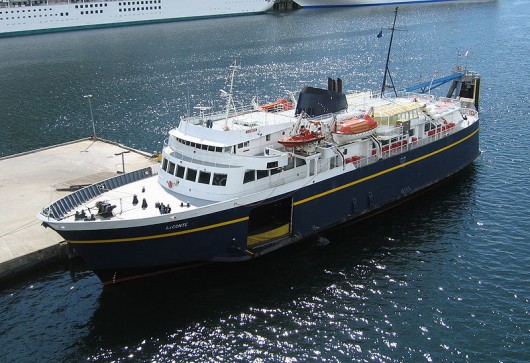
Governor Mike Dunleavy’s proposed ferry budget would be a slight increase in spending on the Alaska Marine Highway System. But senior state transportation officials warn that long gaps will be the new normal.
“AMHS will provide significantly less services, leaving many communities without service for up to six months,” reads page 6 of the governor’s transportation operating budget released earlier this month.
The $49.9 million appropriation would be slightly more than the previous year. But there will be long lulls between ships.
“Communities will have service gaps. There’s no doubt about that,” Department of Transportation Deputy Commissioner Mary Siroky told CoastAlaska. “But I don’t know if a service gap is going to be six months, five months, four months; we don’t have that figured out.”
That’s been the reality for coastal communities on Prince William Sound and smaller Southeast town like Angoon.
Angoon Mayor Joshua Bowen says the city recently hired a private boat to take residents to Juneau for groceries and other supplies. Its 450 residents hadn’t seen a ferry for more than a month.
“We spent $13,100 chartering those two catamarans,” he said.
Some 47 passengers shelled out $75 for a one-way ticket — more than they would’ve for a state ferry — but, that didn’t cover the cost of the charter.
The city lost about $8,000 on the venture. It won’t be repeated any time soon. Bowen says the private sector can’t fill the gaps left by the state ferry service.
“I don’t see it working without some sort of subsidy,” Bowen said. “For the smaller towns that just don’t have the numbers.”
The ferry Tazlina was able to make a couple recent runs to Angoon. But only after the state brought heavy equipment to operate Angoon’s broken ramp.

Normally this isn’t necessary. The ferries LeConte and Aurora are designed to handle these small docks without assistance. But in a cost-cutting move, the state laid up the Aurora rather than fix it. And the LeConte is out for repairs until May.
Siroky says budget realities mean fewer ferries are the new normal.
“There is no way that the marine highway system will be able to provide the kind of service they did the year before this,” she said.
Last year, Dunleavy’s austere budget proposal would have shut down the ferries in October. That didn’t happen.
Instead, he reached a deal with lawmakers who slashed ferry funding by $43 million. Legislators later tried to add $5 million back to the ferry budget — Dunleavy vetoed it.
But that initial threat to end ferry service and the compromise budget that’s led to less service has been widely unpopular in coastal communities.
Now the governor’s facing a recall campaign. He’s changed his chief-of-staff, budget director and he’s also changed his tack.
Reporters at the Governor’s Mansion holiday party in Juneau asked about the state of the ferries. He said that help could be on the way.
“We’re looking at the possibility of getting some help there with $20 million dollars out of the LNBA,” the governor said.
The Legislative Budget and Audit Committee reviews budget requests from the executive outside of the normal budget process.
“We’re looking at coming up with some solutions, long-term solutions for the marine highway system,” Dunleavy added. “We know it’s important to the people of Alaska, especially on the coast that use it.”
The Dunleavy administration commissioned a $250,000 private consultant study to remake the Alaska Marine Highway System. It was delivered in October. But the state has pushed back its public release until January.

DOT Deputy Commissioner Mary Siroky couldn’t confirm the governor’s numbers. She says she understands her agency is asking for something closer to $5 million.
“The department is working on a supplemental budget request that I don’t know where that $20 million number came from,” she said.
Meanwhile, Angoon is doing what it can to keep goods and people moving. Bowen says a city-owned excavator is being repaired. The hope is that it can operate the ramp without the state’s help so the Tazlina ferry will be able to return next month.
“We’re not just sitting here feeling sorry for ourselves,” the mayor said. “We’re trying to figure out ways that we can help the state help us. And we understand that it’s, you know, it’s an expensive thing. And, and we’re just trying to do our part to keep the ferries rolling.”
But fewer and fewer ferries are rolling.
The Tazlina is being pulled out of service on January 19 for modifications so it can sail with a smaller crew. That’ll leave just two ferries: the Lituya running between Ketchikan and Metlakatla. And the mainliner Matanuska crisscrossing Southeast.
But that larger ferry can’t get into to coastal towns with small docks: communities like Angoon, Tenakee Springs and Pelican.
Those towns will likely go without service until at least May.






























